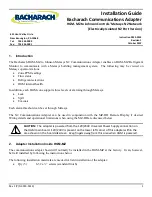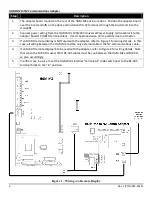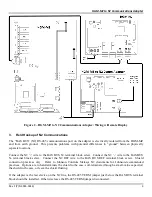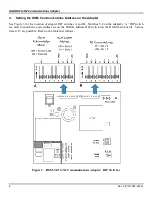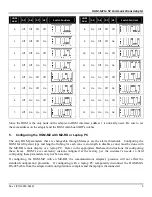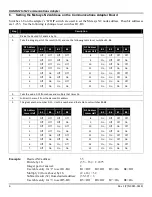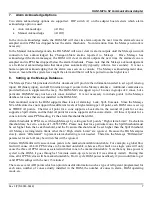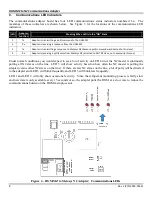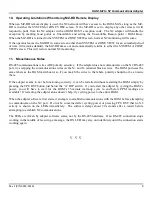
HGM-MZ to N2 Communications Adapter
Rev 1 (P/N 3015-5514)
7
7. Alarm Acknowledge Options
Two alarm acknowledge options are supported. DIP switch A1 on the adapter board selects which alarm
acknowledge option is used.
•
Auto Acknowledge
(A1 On)
•
Manual Acknowledge
(A1 Off)
In the Auto Acknowledge mode, the HGM-MZ will clear its alarm outputs the next time the alarmed zone is
sampled and its PPM has dropped below the alarm thresholds. No intervention from the Metasys network is
necessary.
In the Manual Acknowledge mode, the HGM-MZ will never clear its alarm outputs until the Metasys network
connection has acknowledged the Change-of-State alarms reported to Metasys. Once Metasys has
acknowledged the alarm messages, the HGM will clear its alarm outputs the next time the alarmed zone is
sampled and its PPM has dropped below the alarm thresholds. Please note that the Metasys acknowledgement
is a field-level acknowledgement that takes place automatically (typically within a few seconds). It is not a
human operator acknowledging that the alarm was seen on a console. The Metasys acknowledgement does,
however, mean that the system has caught the alarm and that it will be reported to some higher level.
8. Setting up the Metasys Database
The Metasys Point Map included with this document will provide the information needed to set up AI (analog
input), BI (binary input), and ADI (internal integer) points in the Metasys database. Additional comments are
provided below to supplement the map. The HGM-MZ can support up to 16 zones in groups of 4 zones, but a
particular HGM-MZ may not have all zones installed. It is not necessary to include points in the Metasys
database for zones that are not installed in the HGM-MZ.
Each monitored zone in the HGM supports three levels of alarming: Leak, Spill, Evacuate. Since the Metasys
N2 architecture does not support three different levels of high alarming per AI point, each HGM zone is set up
as THREE AI points. The first AI point for a zone supports a Leak Alarm, the second AI point for a zone
supports a Spill Alarm, and the third AI point for a zone supports an Evacuate Alarm. All three AI points for a
zone return the same PPM reading, it’s the alarm thresholds that differ.
Alarm thresholds in PPM are set through Metasys by setting each AI point’s “High Alarm Limit.” Each alarm
threshold may be set to a value of 1-65535 PPM. Please note that for a particular zone, the Spill threshold must
be set higher than the Leak threshold, and the Evacuate threshold must be set higher than the Spill threshold.
All Metasys warning/alarm limits other than “High Alarm Limit” are ignored. Because the HGM samples
slowly, alarm “differential” to prevent alarm chattering is not needed. Therefore the Metasys “Differential”
parameter for each AI may be written but will be ignored.
Certain HGM faults will cause various points to be marked unavailable/unreliable. For example, a global flow
fault will cause ALL AI PPM values to be marked unreliable, whereas a flow fault on a single zone will only
cause the three AI PPM values associated with that zone to be marked unreliable. Note that any time power is
cycled to the HGM, it goes through a 15-minute warm-up cycle (even if it was already warm!). During this
time, all AI PPM values will be marked unreliable. Don’t cycle HGM power needlessly if you would like to get
valid PPM readings with the next 15 minutes!
There are several ADI points which can provide useful information such as type of refrigerant programmed for
each zone, number of zones actually installed in the HGM, the number of zones in alarm, HGM operating
mode, etc.

